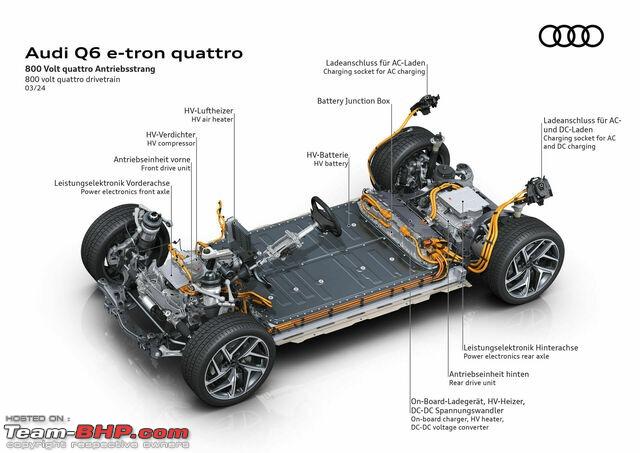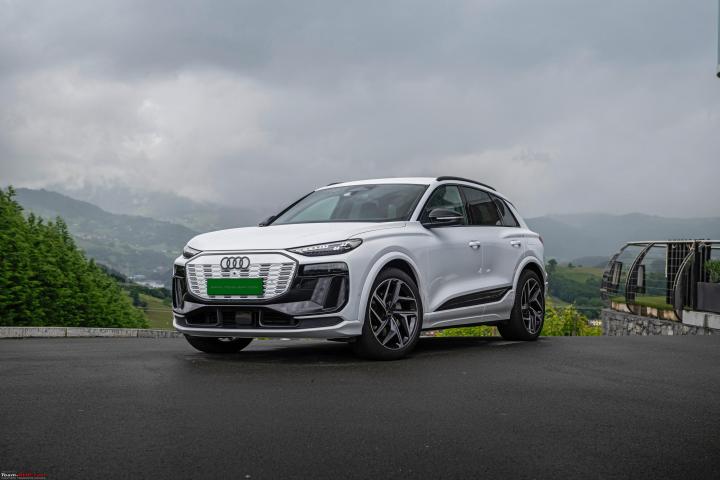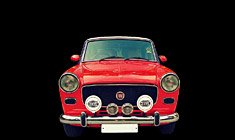News
2024 Audi Q6 e-tron : Our observations after a day of driving
Overall, drivers will find Q6 performance very sprightly but in a mature sophisticated way. For those looking at that league of performance combined with German all-round sophistication, there is the pricier SQ6 which gives the best performance as well as a respectable range.
Driving the Q6 e-tron
Let's start off with the numbers because they are truly impressive. At the heart of the Q6 e-tron are the brand new electric motors and a newly developed lithium-ion battery with a capacity of 100 kWh. This all-new setup produces a whopping 382 BHP.
The Q6 has a maximum speed of 210 km/h and a 0-100 km/h acceleration time of 5.9 seconds (just a hint slower than the Q8 e-tron’s 5.7 seconds). The car's WLTP range is 625 km. Where the Q6 is f-a-s-t, the SQ6 will be blistering. The maximum engine power of the SQ6 is rated at 509 BHP. Its top speed is 230 km/h and the 0–100 km/h (with launch control) is claimed to be 4.3 seconds (that’s M340i territory for equivalent reference)! All this, of course, is at the cost of the range, which is still an astonishing 598 km (WLTP). This is a proper performance car with an actual usable range to boot. At the other end of the spectrum, there is also a ‘performance’ longer range variant which will produce 322 BHP and extend the car’s range to 641 km.
Our drive was organised over a few hours spread across two days in the region around Bilbao and San Sebastian. The route offered a mix of smooth highways as well as some twisty mountain roads, allowing us to experience the car in different kinds of road conditions, albeit all of it on very good quality roads. Since the car was shared between two teams with time also spent on site for photos and technical presentations, drive time per person totalled to a little over a couple of hours. Also, while we drove the Q6 on the first day, due to some mix-up on the second day, the SQ6 that was supposed to be handed to us was inadvertently taken by another team. As a result, unfortunately, our first-hand driving impressions for this report are limited to the Q6 variant only.
Step on the A pedal and the car takes off swiftly and smoothly, without the typical drama associated with an ICE engine. It is extremely smooth, very fast (although it did not feel ‘push back in the seat’ fast – that’s something I’m pretty sure the SQ6 will deliver in spades) and dynamically sorted. The driving modes include off-road, efficiency, comfort, dynamic and balanced modes. The balanced mode in particular is interesting – it learns and adapts to the user’s style of driving.
The regen works extremely well and I toyed around generously between the two regen modes as well as single pedal driving. This takes some getting used to if you're not familiar with it, but it's easy to adapt to reasonably quickly. I was most comfortable driving with level 2 regen which seemed to give me the best feel of driving with the regen braking style of driving. The tech at play is user friendly and even though extensive, never overwhelming. The navigation, speed, etc. is easy to follow via the blue arrows in the head-up display and overall, the entire cockpit experience is excellent.
Whack the throttle and this car is rewarding in a typical electric way. The car delivers its power in a fast but predictable, smooth and linear manner with seamless acceleration across the entire speed range that we operated at on fast highways. The car is fun to drive in the twisties as well but that experience is best reserved for the next section, where we discuss its dynamic prowess.
Overall, drivers will find Q6 performance very sprightly but in a mature sophisticated way. For those looking at that league of performance combined with German all-round sophistication, there is the pricier SQ6 which gives the best performance as well as a respectable range.
Open the bonnet and you are greeted with a clean and clutter-free frunk design, thanks to the placement of the battery at the base:

64 litres of frunk storage:

Suspension
I do not have a lot of experience driving Audis, so I was not sure what to expect from driving the Q6 from a ride, handling and steering perspective. In a nutshell, I was blown away by its dynamic prowess.
The new passive damping system FSD (Frequency Selective Damping) operates and adapts in real-time to ensure top-notch ride comfort on really bad roads as well as managing car movement. The adaptive air suspension with its controlled damping on the other hand suitably compensates for load via level control. The combination of the electronics and mechanical setup translate into an excellent balance between dynamic handling, performance and ride comfort. All this tech and hardware also, of course, makes for, I imagine, expensive repairs or maintenance in the long term. I’d be interested to understand the associated cost of ownership over several years for these high tech setups.
All the test cars were shod with 21" wheels as well as the optional electronically controlled sports air suspension which comes with a continuously variable adaptive damping system. The resultant ride was plush with the only caveat that we really couldn’t test it in conditions that are closer to the appalling roads that our country serves up in spades. I expect the car to be specced with the more practical 19" or 20" wheels in India given our road conditions.
I spent my fair share of time in the back seat as well to get some perspective for the chauffeur driven and it did not disappoint. At the back too, the ride was extremely comfortable. Despite being pushed hard from time to time, the car delivers a really plush ride quality for all passengers, whether at the front or at the back. While we did not drive the SQ6, my understanding is that the entire ride and handling setup is slightly tweaked for a slightly sportier bias.
Coming to the steering – it was absolutely on point, neither too light, nor too heavy and always dead accurate. Select dynamic mode and the car feels nice and taut with a sharp and accurate steering to point and shoot as you please. There is no vagueness in centre whatsoever and even in comfort mode, the steering provides brilliant feedback.
As per Audi, the systems and components making up the chassis are mostly new developments. It was explained to us that the front axle too has a new design, where for the first time the control arms are arranged in front of the suspension arms and in the direction of travel, for both better dynamics and also in keeping with the position of the HV battery. This is claimed to deliver better steering feedback as well as agility, with the steering rack being firmly bolted to the subframe. The rear tyres too are wider and combined with the operation of the twin battery setup, the car has a slight rear wheel-biased torque distribution.
The braking too is brilliant with the brakes providing excellent feedback and integrating seamlessly with the regen. Given the route involved public roads, I did not want to risk simulating any urgent brake test manoeuvres though.
Adaptive air suspension is an optional extra:

The ASM / PSM combo means it's the rear motor which is always working in this Quattro setup. The car has a nice rear wheel bias, unlike most Audis:

Drive and Battery system
Audi explained the new scalable electric drive system as well as the battery architecture that are at the heart of the Q6 and the SQ6.
Audi has made considerable efforts to ensure that these newer designed drives are more compact than existing designs, therefore requiring less installation space. These have also been designed to be about 20% lighter and more efficient. The motors are built in the company's drivetrain plant in Gyor, Hungary – said to be the largest powertrain plant in the world.
Audi has also extracted much superior power-to-weight performance from the PPE electric drives. The ASM drive on the front axle only comes into play when the driver seeks to extract maximum performance – at all other times, it is the compact PSM of the rear axle at play, giving the car the sweet rear wheel torque bias that we spoke about earlier. Audi is leveraging the scalable nature of this powertrain to launch the car in two models with all-wheel drive and two different performance levels - the Q6 and the SQ6. More models will follow such as an entry-level rear-wheel drive variant focussed on longer range and a Sportback version too.
Coming to the battery, the newly developed 100 kW high voltage battery is assembled at Ingolstadt. The battery comprises just 12 modules, with 15 cells per module connected in series. For reference, the Q8 e-tron battery consists of 36 modules and 432 cells. Audi claims that this provides the best balance between range and charging performance. The battery architecture too has increased energy density thanks to its increased nickel content from the 8:1:1 ratio of nickel, cobalt and manganese. The battery is lighter, requires less installation space and can be better integrated into the vehicle’s crash system. The battery management controller (BMC) manages the current regulation. The 800V battery is divided into two partial batteries with half the nominal voltage each, which are charged in parallel to allow for faster charging.
The Audi Q6 e-tron Quattro charges with 11 kW alternating current (AC). A 22 kW version is to follow at a later point. Maximum charging power of up to 270 kW for DC charging generates a recharged range of up to 255 km in around ten minutes; around 21 minutes is enough to recharge the HV battery from 10 to 80 percent during HPC charging. One hopes that we will see faster charging networks becoming more mainstream to make the most of these fast charging abilities.
800V architecture with 2x400 bank charging possible:

Uses an ASM (asynchronous motor) on the front axle and PSM (permanent-magnet synchronous motor) on the rear axle:

Continue reading the discussion on the 2024 Audi Q6 e-tron on our forum.




_4.jpg)
.jpg)












